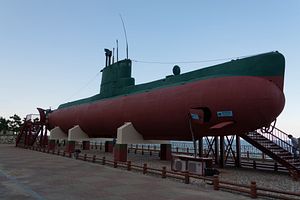Over 50 North Korean submarines have left their homeports, according to a local media report. “Seventy percent of North Korea’s submarines left their bases, and their locations are not confirmed,” a South Korean military official told Yonhap News.
According to South Korean military officials, this constitutes the largest deployment of North Korean submarines since the end of the Korean War. U.S. and South Korean aircraft as well as naval vessels have so far unsuccessfully tried to locate the subs, making it difficult to ascertain whether their deployment is just a show of force, or whether they have received specific instructions to target South Korean shipping in the event of an escalation. “No one knows. We are mobilizing all our surveillance resources,” said a South Korean military spokesperson.
“This is a typical North Korean tactic of talking on one hand and brandishing military power on the other to try to force their way,” he added. After an escalation of tensions last week (See: “North Korea is Mobilizing For War”), Seoul and Pyongyang are currently engaged in their first high-level talks since February 2014 (See: “Amid ‘Quasi State of War,’ North, South Korea Hold First High-Level Talks in a Year”) with little progress so far.
While Pyongyang’s subs recently made headlines with the testing of a submarine-launched ballistic missile (SLBM), North Korea’s submarine force purportedly consists of 70 mostly obsolete boats, primarily used for coastal defense and reconnaissance operations, with limited capability for more offensive anti-ship operations (partially mostly due to lack of long-range air cover). The Korean People’s Navy (KPN) is believed to possess 20 Romeo-class vessels, 1,800-ton diesel-electric subs based on 1950s Soviet technology; 40 home-built 370 tons Sang-O-class diesel-electric submarines specifically designed for the insertion of special operation forces into the South but also capable of laying mines and conducting antisurface warfare; and approximately ten 130 tons Yono-class midget submarines.
A Yono-class midget submarine was allegedly responsible for the 2010 sinking of the South Korean naval vessel Cheonan that killed 46 sailors and it is these vessels that could potentially cause the most harm to U.S. and South Korean naval forces using “hit-and-run” tactics during sea denial operations. “The KPN’s ‘wolf pack’ of mini-submarines are each physically smaller (typically half the length of the Romeo/Type-033), more concealable and possibly more maneuverable within the numerous bays and inlets dotting the North Korean coast,” according to Koh Swee Lean Collin.
The fact that U.S. and South Korean forces have so far had difficulties locating any of the 50 KPN subs could suggest that the majority of the vessels have been deployed along North Korea’s coastline hiding in coves and inlets, with perhaps only the Yono-class midget submarines sent outside North Korean territorial waters.

































